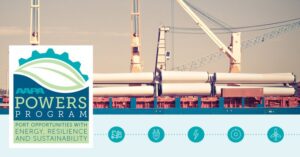
As global conflicts, stronger storms, and heat waves threaten supply chains, addressing climate change while keeping energy supplies secure can seem daunting. To solve these challenges, governments, private industry, and consumers will have to look for creative and innovative solutions. With the Port Opportunities with Energy, Resilience, and Sustainability (POWERS) Program, AAPA makes the case for port investment as a critical tool in our fight against climate change and for energy security.
But why ports? Why not leave these decisions to the federal government or other industries? Through the coronavirus pandemic, America has learned to ignore ports and maritime transportation at its own peril. As American consumers stayed socially distant, they spent less money on travel and entertainment, and more on goods. As this wave of furniture, exercise equipment, and gaming consoles flooded our shores, some ports got backed up. These backups cascaded outward, causing congestion and shortages at rail yards, truck depots, retailers, manufacturers, and foreign ports. Much of this congestion has since been unwound, but it taught us a lesson: as a key node in the supply chain, what happens at ports will affect every aspect of the world economy.
In the POWERS Program, AAPA seeks to use that cascading effect to America’s and our allies’ advantage. AAPA’s membership has agreed on five policy pillars to position ports to be leaders in the years to come:
- Bolstering the capacity to export made-in-America energy, especially with Russia’s war in Ukraine threatening to leave Europe in the cold.
- Creating a new American industry in the production of alternative fuels to power the vessels and land-side equipment of the future, including hydrogen, LNG, ammonia, biofuels, methanol, and more.
- Electrifying America’s ports, through the installation of electric cargo-handling equipment, shore power, charging stations, and microgrids.
- Hardening our infrastructure against energy shortages, rising seas, heat waves, and stronger storms.
- Preparing physical and human infrastructure to build American offshore wind.
Each of these pillars represents an opportunity to create American jobs, protect our industries from environmental threats, mitigate greenhouse gas emissions, and create opportunities for American businesses and engineers to create new industries through their ingenuity.
Ports are multimodal hubs. Marine cargo vessels, trucks, trains, cruise vessels, agriculture, containerized cargo, break bulk cargo, liquid energy, electric transmission lines, passengers, and more all meet in one location. This rare confluence of industries means innovations implemented at ports will cascade outward.
Take hydrogen as an example: Hydrogen production today is done on a small scale, but this simplest atom has the potential to power several aspects of our economy’s future. Hydrogen can be used to power marine vessels without emitting any greenhouse gases. It can also be used in fuel cells to power trucks, cold ironing operations, or in production of methanol and ammonia to power ocean-going vessels. Hydrogen can be produced with natural gas, taking advantage of an ample resource, or it can be produced from wind energy, amplifying the benefits of a burgeoning industry.
When a port invests in hydrogen infrastructure, it will attract the business of all cargo types and modes of transportation. If ports across America invest in hydrogen, it will create a national industry that positions us as a world leader in energy and sustainability goals. A single producer of hydrogen could find themselves with vessel operators, truck drivers, and rail companies as their customers. Multimodality is ports’ greatest asset, and resilient ports can be America’s greatest asset too.
The Bipartisan Infrastructure Law and Inflation Reduction Act were passed by Congress to revitalize American infrastructure and give American industry sustainability resources. Ports now have a unique opportunity, with billions of dollars in federal funding coming their way over the next several years. There are several Federal programs designed to bolster port infrastructure, and several that are at the discretion of federal agencies to distribute. With the POWERS Program, AAPA will advocate for every dollar possible to build out ports’ maritime and multimodal infrastructure. We will advocate for policies to streamline permitting, ensure energy supplies are consistent, and acquire the resources for sustainable technology.
There are ample opportunities for readers to get involved in the POWERS Program. AAPA hosted its first-ever POWERS Summit and Expo (January 2023) in Tampa Bay, FL. AAPA has also launched a website for the POWERS Program (aapapowers.com). There, you can read original articles from AAPA members and partners, access innovative reports and resources, and see the more than 20 companies and nonprofits that have signed on in support.
In the fight against climate change and the necessity for reliable energy sources, every day is more critical than the last. To accelerate America’s progress and create new economic opportunities, there is no better place to invest than ports.
 AAPA Seaports
AAPA Seaports


